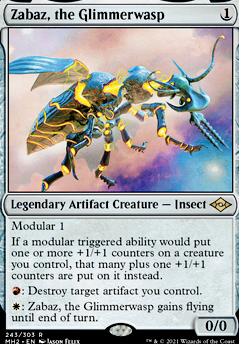Artificial Stairs
Initially I just wanted to see how far you can take a five-color modular deck. Answer: not very far.
But even though I moved away from a strict dedication to modular, you can still see the bones of that in the build. I've also found that there are a few useful perks to relying on artifacts. You get access to a few extra mana fixers, like
Etherium Sculptor,
Starnheim Courser,
Power Depot, and there is artifact support in every color.
Playing the Deck
Unfortunately, with Rainbow Stairwell, it's very hard to control mana curve. This makes it hard to predict structure of games. That said, I'll lay out some basic points.
Starting Hand
It's important to have at least 2 lands in your starting hand, preferably 3. Make sure you have one multicolored land (eg. Power Depot, Thornglint Bridge), and a land that matches at least one card in your hand.
Early Game
Don't worry about successfully dropping anything on turn one, but make sure you can put down something hostile (eg. Glaze Fiend, Zabaz, the Glimmerwasp, etc.) by turn two. You want at least one modular creature and one other artifact creature out by turn three, otherwise you risk the modular ability going to waste.
Late Game
To be honest, this deck is not complicated. Drop big things with modular (like Skyreach Manta or Arcbound Wanderer), and one of the heavy hitters (Noxious Gearhulk, Verdurous Gearhulk, Ezuri's Brigade, and Thundering Tanadon) and a couple of flyers, then swing until your opponent stops moving.
Card Selection
There are some obvious cards missing here, like the good tutors (especially Enlightened Tutor,Vampiric Tutor, Sylvan Tutor, and Demonic Tutor), the good dual lands, Mycosynth Lattice, Aether Vial, Prismatic Vista, Arcbound Ravager, The Immortal Sun, and a few other great cards. The reasoning is simple: too expensive. This deck is worth anywhere from 20 to 50 dollars, and most of those cards would immediately double that price (or more).
The Rainbow Stairwell Format
Rainbow Stairwell is my favourite format in MtG at the moment, followed by EDH and pauper. It's a singleton format with a boat-load of restrictions that make for challenging deck-building!
The problem with Rainbow Stairwell as a format is that there is a lot of disagreement about what the format actually entails. I would argue that the
2011 article on the WotC website (https://magic.wizards.com/en/articles/archive/serious-fun/stairway-compleation-2011-05-09) is the closest to an official guideline we have. It presents the following rules:
- Your deck must be exactly 60 cards, six cards from each of the five colors as well as six artifacts or colorless cards.
- Additionally, you must have one each, for each color, of cards with converted mana cost one through six. That is, you much have a staircase of cards starting at one mana and moving up to six, for each color.
- Multicolored cards are not allowed.
- Singleton: no duplicate cards, except for basic lands.
A very popular rule is to disallow sideboards, which I have done. If you would include a sideboard, this deck's maybeboard could simply be used as a mildy effective sideboard.
I have seen other popular variations however, including a 56-card setup (4 of each basic land, no nonbasic), versions requiring a full set of dual lands, banning X in mana cost, and using multicolored cards that count as only one of their colors, but those seem less common. I have also seen the additional rule that cards cannot target nonbasic lands, but that seems more like an etiquette thing than a firm rule. None of my Rainbow Stairwell decks follow these additional rules.

